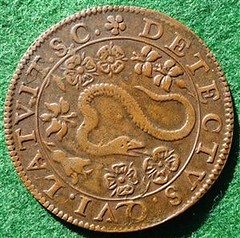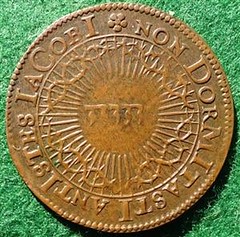
PREV ARTICLE
NEXT ARTICLE
FULL ISSUE
PREV FULL ISSUE
V25 2022 INDEX E-SYLUM ARCHIVE GUY FAWKES DAY NUMISMATICSWell-read numismatists can fairly easily dream up a numismatic connection to just about anything. Yesterday was Guy Fawkes Day in England. Quick - name a numismatic connection. Stumped? Here's some background - a nice summary from The Writer's Almanac. -Editor
Today is the British holiday known as Guy Fawkes Day. Fawkes was born in 1570; he was a tall, well-built man with thick reddish hair and a quick mind. A school friend described him as So, on November 5, 1605, Fawkes was attending to the 36 barrels of gunpowder that the conspirators had stashed under the House of Lords. Authorities stormed the cellar, tipped off by an anonymous informant, and arrested Fawkes. They tortured him for two days before he gave up the names of his co-conspirators, at which point he was sentenced to death for treason. Traitors were typically hanged, drawn, and quartered — a grisly and slow death — and Fawkes knew this. So, on the day of his execution, he jumped from the gallows, breaking his neck and dying instantly. To celebrate the foiling of the Gunpowder Plot, the king's subjects lit bonfires, shot off fireworks, and burned Guy Fawkes and his fellow plotters in effigy. I celebrated the day one year in the early 1980s with a group of Brits I worked with at Bell Labs in New Jersey. Fun evening. A crisp fall night, the event was in a backyard with a roaring fire, plenty of snacks and alcoholic punch, and what looked to me like a scarecrow made of old clothes stuffed with newspaper. Later in the evening, the cries began - "Burn the Guy! Burn the Guy!" And they tossed the Guy Fawkes effigy into the flames to much applause and merriment. A longtime popular symbol of protest, Guy Fawkes masks are often worn at rallies today - see the article linked below for background. Anyway, I emailed some of our British contributors to wish them a Happy Guy Fawkes Day and not surprisingly, one of them replied with a great numismatic connection, and it's a chronogram to boot. Thank you, David Pickup! -Editor Terrorist Plot Foiled Copper jeton or medal which commemorates the foiling of the Gunpowder plot. It is unsigned, and shows a snake gliding among lilies and roses on the reverse with the inscription,
DETECTVS • QVI • LATVIT S • C • which means
On the reverse is the name of Jehovah written in Hebrew script within a border of thorns. The reverse bears the inscription NON DORMITASTI ANTISTES IACOBI, translating to Some of the letters are slightly bigger than the others. This means the date is written chronogrammatically which means some of letters in Roman numerals add up to the date. NON DORMITASTI ANTISTES IACOBI
M = 1000
= 1605 David also has an article in Coin News "Remember Remember the fifth of November" about Thomas Knyvet, Member of Parliament who played a part in uncovering the plot. -Editor
"A tragedy was prevented because the authorities were tipped off and they conducted a thorough search of the cellars. Thomas Knyvet, (sometimes spelt Knyvett) was a Member of Parliament, had a leading part in uncovering the plot. He was a Royal courtier and went on to have an important position and career at the Mint. Thomas Knyvet's link to coins started when he served as Warden of the Royal Mint from 1599 to 1621. He was paid an official salary of £100 plus £20 for his clerk and in 1621 he was joint warden with Edward Doubleday. He was involved in a dispute with a colleague about the quality of coins that lasted for many years and even the King's judges could not sort it out. The argument was with the elderly Sir Richard Martin, who was Master of the Mint and Knyvet's predecessor."
To read the complete articles, see:
Wayne Homren, Editor The Numismatic Bibliomania Society is a non-profit organization promoting numismatic literature. See our web site at coinbooks.org. To submit items for publication in The E-Sylum, write to the Editor at this address: whomren@gmail.com To subscribe go to: https://my.binhost.com/lists/listinfo/esylum All Rights Reserved. NBS Home Page Contact the NBS webmaster 
|



